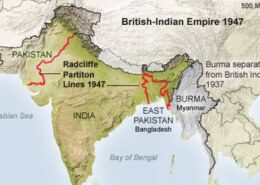Talk about the importance of the Cripps Mission and the Cabinet Mission Plan’s inability to break the impasse over the constitution during the last stages of the Indian independence struggle.
Model Answer Introduction The Quit India Movement, launched on August 8, 1942, was a pivotal moment in India's struggle for independence, driven by a series of events that highlighted the growing discontent with British rule during World War II. Events Leading to the Quit India Movement Growth of InRead more
Model Answer
Introduction
The Quit India Movement, launched on August 8, 1942, was a pivotal moment in India’s struggle for independence, driven by a series of events that highlighted the growing discontent with British rule during World War II.
Events Leading to the Quit India Movement
- Growth of Indian Nationalism: The 1930s and 1940s saw a surge in Indian nationalism, with leaders like Gandhi, Nehru, and Subhas Chandra Bose energizing the population through movements such as the Civil Disobedience Movement, which created momentum for the final push against British rule.
- Impact of World War II: The British decision to involve India in World War II without consulting Indian leaders led to widespread resentment. In 1939, the Indian National Congress resigned from provincial governments in protest, deepening dissatisfaction among Indians.
- Economic Exploitation and Famine: The war exacerbated economic exploitation and led to severe famines, further worsening public discontent.
- Failure of the Cripps Mission (1942): The Cripps Mission, which offered limited post-war dominion status, was rejected by Indian leaders, including Gandhi, as it did not promise immediate self-rule. This failure intensified anti-British sentiment.
- Rejection of Self-Government: By 1942, frustration grew over the British refusal to grant self-government, fueling nationalist sentiment. The Indian National Congress began advocating for the British to “Quit India.”
- Subhas Chandra Bose and the INA: Bose’s efforts to form the Indian National Army (INA) and seek foreign support for independence demonstrated the lengths to which nationalists would go for freedom.
- Mahatma Gandhi’s Leadership: Gandhi’s commitment to non-violent resistance inspired millions, culminating in his call for mass mobilization under the slogan “Do or Die,” leading to the launch of the Quit India Movement.
Results of the Quit India Movement
- Mass Uprisings and Repression: The movement sparked widespread protests and strikes, which were brutally repressed by the British, resulting in thousands of arrests.
- Unified National Spirit: The movement fostered a strong sense of national unity, bringing together diverse groups in the fight for independence.
- End of British Colonial Legitimacy: The movement demonstrated that British rule had lost its legitimacy in the eyes of Indians, accelerating the demand for independence.
- Increased Repression: The British response involved severe repression, arresting over 100,000 leaders and activists, which reinforced the determination of the Indian populace to fight for freedom.
- Emergence of Parallel Governments: Local parallel governments emerged in some regions, challenging British authority and showcasing the desire for self-rule.
- Strengthening of the Indian National Congress: Despite the arrests, the Congress solidified its role as the leading force in the independence movement.
- Foundation for Post-War Negotiations: Although the movement did not achieve immediate independence, it laid the groundwork for post-World War II negotiations, leading to the eventual transfer of power in 1947.
- International Attention: The Quit India Movement garnered international attention, increasing global support for India’s independence cause.
Conclusion
The Quit India Movement marked a critical turning point in India’s freedom struggle, demonstrating the ungovernability of India under British rule and laying the foundation for eventual independence in 1947.
See less

Significance of the Cripps Mission and the Failure of the Cabinet Mission Plan in Resolving the Constitutional Deadlock During the final phase of the Indian independence movement, the Cripps Mission and the Cabinet Mission Plan were crucial attempts to address the constitutional deadlock and facilitRead more
Significance of the Cripps Mission and the Failure of the Cabinet Mission Plan in Resolving the Constitutional Deadlock
During the final phase of the Indian independence movement, the Cripps Mission and the Cabinet Mission Plan were crucial attempts to address the constitutional deadlock and facilitate the transfer of power from British rule to Indian hands. However, both faced significant challenges and ultimately failed to resolve the deadlock. Here’s a detailed discussion on their significance and the reasons for their failure.
1. The Cripps Mission (1942)
Objectives and Proposals:
Significance:
Failure:
2. The Cabinet Mission Plan (1946)
Objectives and Proposals:
Significance:
Failure:
3. Impact and Legacy
Impact on Independence Movement:
Legacy:
Conclusion
The Cripps Mission and the Cabinet Mission Plan were significant attempts to resolve the constitutional deadlock during the final phase of the Indian independence movement. While they represented crucial steps towards negotiating independence, their failures illustrated the deep-seated communal divisions and political challenges that ultimately led to the partition of India. These events reflect the complex interplay of historical, political, and social factors that shaped the course of Indian history.
See less